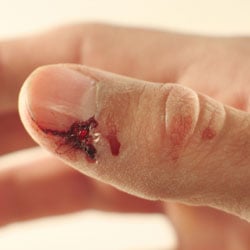
Finger and Toe Injuries
12 January 2009
A finger or toe injured in a car door or jammed against a hard object is a common injury in children. If this happens to your child, he/she should be seen by a healthcare provider to assess the injury.
For older children, injuries that only involve the end segment of the finger or toe and not a deep or bad cut, can often be treated at home.
Types of injuries to fingers and toes:
- Minor breaks of the bone in the tip of the finger or toe are often left untreated. However, some breaks may need to be splinted.
- Blood often pools under the nail of the injured finger or toe, causing severe throbbing pain. A doctor can relieve this pressure by draining the blue-black blood you can see through the nail.
- Often the nail is partly pulled off during the incident. Do not pull it off. See your doctor, who may be able to fix it.
Treatment for injuries to fingers and toes:
There are several steps you can take to relieve pain and speed healing for your child’s injured finger, toe or torn nail.
1. Crushed finger or toe:
- If your child can move his/her finger or toe easily and the injury does not involve the nail bed, apply an ice pack to reduce swelling. Also use acetaminophen or a similar over-the-counter pain reliever.
- If the finger or toe is bleeding, apply pressure on the wound and elevate above the heart until bleeding stops. Wash the wound with soap and water, and watch for any signs of infection, such as redness and swelling.
- If a bone fracture is suspected or the injured finger or toe involves a deep or serious cut, seek medical attention right away.
2. Torn nail:
- Clip carefully along the line of the tear.
- Soak nail for 20 minutes in cold water to reduce swelling.
- Apply antibiotic ointment and cover with non-stick sterile dressing to keep clean.
- On second and third days, cover loosely with an adhesive bandage, use antibiotic ointment, and continue to soak.
- On fourth through sixth days, soak daily in warm salt water (1/4 teaspoon in 8 ounces of water) and apply antibiotic ointment. Cover with non-stick sterile dressing to keep clean.
- On seventh day, stop the soaking and dressing. New skin should have formed.
Seek medical attention if:
- The end of the nail appears to droop
- Significant pain and swelling is present
- There is visible deformity
- There is severe pain is present and there is visible blood under 1/3 of the nail
- There are deep cuts or scratches that may need stitches (edges separate or gape more than 1.2 cm in length); a tetanus booster may be needed
Go to the Emergency Department if:
- There is a crushing or wringer type injury and the injured person is unable to straighten his/her finger or toe
- The nail is completely torn off (bring the nail to the doctor)
- The finger or toe is numb, tingling, or cool to the touch
Reviewed by Trauma specialists at the Montreal Children’s Hospital.
Last updated: July 2013, October 2015
